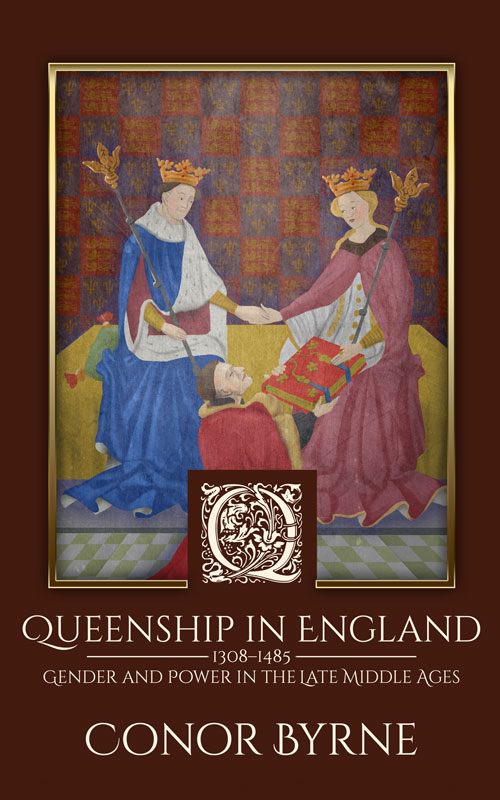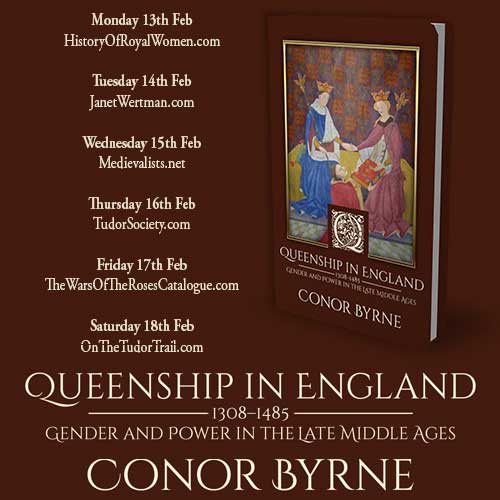I am delighted to be hosting the final day of Conor Byrne’s book tour for his latest non-fiction book, Queenship in England: Gender and Power in the Late Middle Ages. To mark the occasion, Conor has written a fascinating guest post about Joan of Navarre: Duchess of Brittany.
I’m also excited to announce that thanks to the generosity of MadeGlobal Publishing, I have a copy of Conor’s book to give away! (See conditions of entry below).
Between 1308 and 1485, nine women were married to kings of England. Their status as queen offered them the opportunity to exercise authority in a manner that was denied to other women of the time. This book offers a new study of these nine queens and their queenship in late medieval England.
- Isabella of France, wife of Edward II
- Philippa of Hainault, wife of Edward III
- Anne of Bohemia, wife of Richard II
- Isabelle of France, second wife of Richard II
- Joan of Navarre, wife of Henry IV
- Katherine of Valois, wife of Henry V
- Margaret of Anjou, wife of Henry VI
- Elizabeth Wydeville, wife of Edward IV
- Anne Neville, wife of Richard III
The fourteenth- and fifteenth-centuries were frequently characterised by dynastic uncertainty and political tensions. Scholars have recognised that the kings who ruled during this time were confronted with challenges to their kingship, as new questions emerged about what it meant to be a successful king in late medieval England. This book examines the challenges faced by the queens who ruled at this time. It investigates the relationship between gender and power at the English court, while exploring how queenship responded to, and was informed by, the tensions at the heart of governance.
Ultimately Queenship in England questions whether a new model of queenship emerged from the great upheavals underpinning the fourteenth- and fifteenth-century polity.
“An interesting and accessible exploration of medieval queenship in relation to gender expectations.” – Amy Licence, author of Catherine of Aragon: An Intimate Life of Henry VIII’s True Wife
“A very readable and thoroughly researched book that looks at the role of late medieval Queens of England in an original way.” – Toni Mount, author of A Year in the Life of Medieval England
Conditions of Entry
For your chance to win a copy of Queenship in England, you must be subscribed to On the Tudor Trail’s newsletter (if you are not already, sign up on our homepage where it says ‘Free Enewsletter Subscription’).
Then simply leave a comment after this post between now and 25 February 2017. Don’t forget to leave your name and a contact email. Please note that I have comment moderation activated and need to ‘approve’ comments before they appear. There is no need to submit your comment twice.
This giveaway is open internationally.
A winner will be selected randomly and contacted by email shortly after the competition closes. Please ensure you’ve added natalie@onthetudortrail.com to your address book to avoid missing my email.
Good luck!
Joan of Navarre: Duchess of Brittany, Lancastrian Queen
By Conor Byrne
Joan of Navarre was Queen of England between 1403 and 1413 as the second wife of Henry IV of England. Although she is not especially well-known today, Joan’s queenship was highly unconventional for a number of reasons. Firstly, she was the wife of a usurper, for Henry had taken a leading role in the circumstances leading to the deposition of his cousin, Richard II. As Elizabeth Wydeville and Anne Neville, who also married usurpers, were to discover, this was not an especially enviable position for the queen consort to be in. Secondly, Joan had already been married and was in her mid-thirties when she became queen, which was unusual given that contemporaries idealised both virginity and youth in representations of queenship, while most queens tended to marry in their teens. Thirdly, and perhaps most importantly in view of her subsequent reputation, Joan was publicly accused of witchcraft during the reign of her stepson, Henry V. While modern historians are sceptical of the accusations, especially since the possessions that had been seized by the king were later restored to her, the episode demonstrates the difficult circumstances in which a late medieval queen could attempt to function as a political actor. It also reveals the ambivalent situation in which a queen could find herself in the aftermath of her husband’s death.
Before her marriage to the Lancastrian king, Joan had been married to Duke John IV of Brittany, and during her tenure as duchess of Brittany, Joan was praised for her activities as an intercessor. She also provided her husband with nine children, thus safeguarding the continuation of the lineage. After the death of the duke in 1399, Joan acted as her son’s guardian and as regent of Brittany, responsibilities which testified to her contemporaries’ appreciation of her political abilities. During her regency, Joan continued to play an effective intercessory role in, for example, assisting in the ending of the dispute involving Olivier, lord of Clisson and constable of France. Her political astuteness and experience at the heart of government may have identified her as a suitable candidate for Henry IV’s hand, who came to the throne of England the same year in which Joan’s first husband died. Her evident fertility, moreover, likely appealed to the king, who would have been aware that contemporaries generally acknowledged the arrival of royal offspring as evidence of divine favour. As a usurper king, Henry IV was in sore need of divine approval.
Joan’s activities as duchess of Brittany, and later as regent, provided her with invaluable political and administrative experience that queens of England usually lacked prior to their marriage. However, her marriage to Henry IV in 1403 was not popular either at home or abroad. The French continued to regard Henry as their enemy, for he had ousted King Charles’s son-in-law and, as a result, had deprived Charles’s daughter of the English throne. The marriage also occurred at a time of schism within the Church. England supported the Roman pontiff Boniface IX, whereas France lent its support to Benedict XIII, who resided at Avignon. These religious issues were of great importance during the early fifteenth-century.
Moreover, Joan does not appear to have brought her new husband a dowry, which was not ideal given that Henry IV’s financial difficulties were well known. Despite these financial circumstances, Joan was provided with the largest dower received by a queen of England up until that time. However, this grant set in motion a six-year struggle in which Joan attempted to have lands and rents assembled that were equal to the grant’s proportions. The queen was also criticised on account of her foreign entourage, and in 1406 the king was beseeched to order the expulsion of all Frenchmen and Bretons from the realm. Joan was viewed with disapproval because fifteen Bretons served in her household.
The widespread ambivalence to Henry and Joan’s union meant that it would have been highly advantageous for the queen to produce children, especially given the precariousness of her husband’s position, as a usurper king that continued to be troubled by internal dissent and occasional rebellion. Unfortunately for Joan, she failed to provide her husband with heirs, although it is possible that she experienced stillbirths, as one chronicler alleged. Despite this, she managed to maintain stable relations with her husband’s children from his first marriage, including his heir, Henry. Joan’s own childlessness meant that she was required to seek an alternative avenue in which she could exercise influence and contribute to perceptions of her husband’s kingship as legitimate.
Unlike Isabella of France or Anne of Bohemia, Joan does not appear to have been especially renowned for her activities as an intercessor while married to Henry, but extant evidence indicates that she could enjoy success in this sphere. After all, she had enjoyed a good reputation as an effective intercessor during her marriage to the duke of Brittany. In 1405, she entreated Henry to release Breton prisoners that had been captured after a raid on Devon, and two years later she participated in the arrangement of an Anglo-Breton truce. The queen also sought pardons for the abbots of Colchester and Byleigh, as well as the countess of Oxford, whose property was also restored to her.
It was in her household management and in her lordship that Joan primarily exercised authority as queen. Like Margaret of Anjou, Joan sought to protect the interests of her servants and rewarded those who had performed good service. Thus, in 1411, the queen assigned manors to her esquire Thomas Chaucer, and granted the tenancy of her manor at Langley to Thomas Lillebourne and Thomas Gloucester. She was also highly active in securing her rights to property. Joan has been criticised for her greedy, acquisitive nature, mainly on the grounds that she was granted a new tower at the Palace of Westminster in which to organise the handling and auditing of the queen’s accounts and charters, and which was used as a venue for her councils and business. However, the circumstances in which the grant was made are unknown, and it seems unfair to accuse Joan of acquisitiveness in view of this.
The unpopularity of her marriage, and her husband’s continuing struggles to assert his legitimacy as king, did not prevent Joan from exercising authority in the informal spheres of queenship, but it did mean that her position became precarious after the death of Henry IV in 1413. As noted earlier, Joan had maintained stable relations with her stepson, who succeeded his father as Henry V, and evidence indicates that she enjoyed a good relationship with his brother, Humphrey of Gloucester. She continued to receive revenues from both the duchy of Lancaster and the crown, but six years later, the king ordered that her remaining possessions should be confiscated. Joan was accused of sorcery in a bid to seize her dower to fund the king’s war with France and his impending marriage. The charges do not appear to have been widely believed, and the queen enjoyed visits from her stepson Humphrey, as well as from the archbishop of Canterbury and the bishop of Winchester.
However, the episode demonstrated that Joan’s foreignness rendered her vulnerable, at a time when her position was already ambiguous in the wake of her husband’s death. Joan’s childlessness, moreover, meant that she did not enjoy a political relevance as she would have done had her heir succeeded his father as king of England. In a more stable political and diplomatic environment, it is possible that Joan would have continued to enjoy good relations with her stepson, but the war with France necessitated funds. Although her confiscated possessions were eventually restored to her, the accusations directed at Joan testified to a more difficult political climate in which the fifteenth-century queens, Margaret of Anjou and Elizabeth Wydeville, in particular, were to find themselves.
Conor Byrne studied History at the University of Exeter. He is the author of Katherine Howard: A New History and Queenship in England, both published by MadeGlobal. Since 2012 he has run a historical blog and was formerly editor of Tudor Life Magazine. His research to date specialises in late medieval and early modern European history, with a focus on gender, sexuality and the monarchy.
Buy ‘Queenship in England’ on Amazon
Join Conor Byrne on Facebook






















What a very interesting piece! I can’t wait to get my hands on Conor Byrne’s new book– I loved Katherine Howard: A New History!
Me too–Katherine Howard: A New History opened my eyes to an entirely new way of looking at Katherine’s life and its meaning.
This looks very interesting!!! Can’t wait to ready it!
This book sounds absolutely intriguing! Definitely adding this & Conor’s other books to my “want to read” list!
Looking forward to read it! I have never read about them so it would be really insteresting.
This book sounds fabulous!! I can’t wait to read it!!
Never heard of this author before but I’ll definatley be checking out his books now : )
As a history enthusiast, I love to read and find out as much as I can about this era. This era has always interested me. Since I was three years old after my dad read to me something from Sir Thomas Mallory’s the death of King Arthur. After that, I wanted to know everything about the medieval period and then the renaissance era. It wasn’t until I was in second grade that I learned that his retelling of the Arthurian myth was based on the political situation that was happening at the time -the wars of the roses. Hence, my passion grew (and also my love of fantasy which is still growing strong, I am proud to say!)
It is not only Joanne of Navarre I want to learn about but other women addressed in this book, so here’s to hoping I get to win this giveaway!
Been following you for a couple of years, and I always appreciate hearing from guest authors, even though I rarely comment. Thanks so much for sharing the knowledge with us, along with the chance to win this interesting sounding book. Good luck to all!
I would love to read this. I just recently found this blog on Facebook.